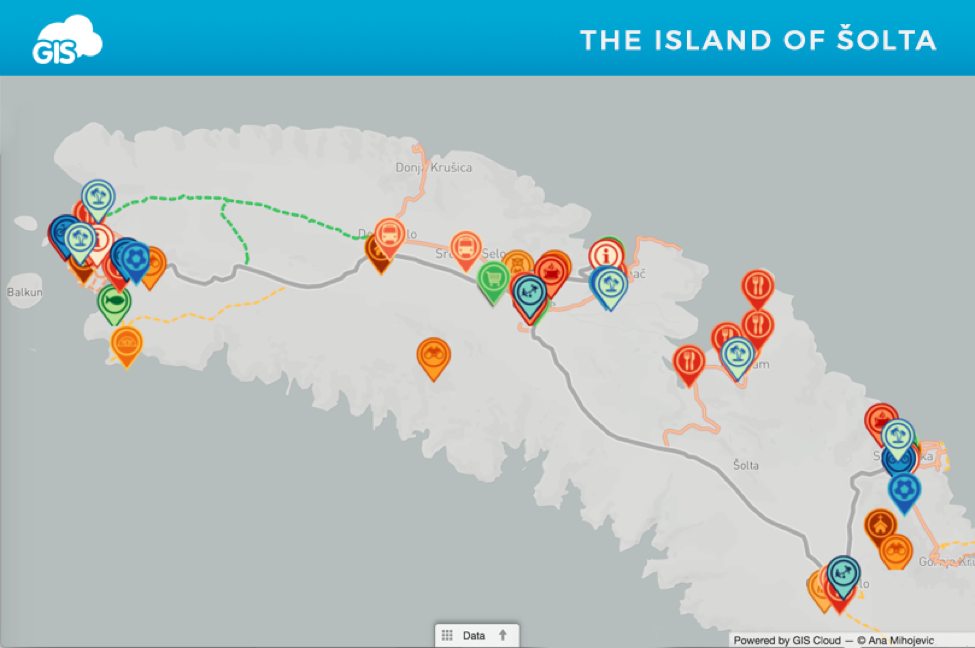
GIS In Tourism – Building an Interactive Map of the Island of Šolta
Tourist maps are one of the most widespread uses of GIS and online mapping, that is accessible and useful for a wide variety of people. Knowing that Tourism is one of the crucial industries to many communities around the world, having an interactive map with all the information necessary for tourists is of great use for all who take part in the related activities. Except for tourist maps, GIS can be also used for different planning and analyzing activities such as building tourist resorts and facilities. It is a great tool for tourist guides, who can have a good overview of important infrastructure, tourist offering, historic places. They can also use maps for planning optimal routes for sightseeing and determining shortest distance between important places, and these are just some of the examples of potential uses of GIS in Tourism.
So, let’s see one real life example of building an interactive Tourist Map using GIS Cloud in a project done by Geography student Ana Mihojevic.
Inspired by the example of the City Crikvenica Map Portal, she decided to create a map of the Šolta island in Croatia. As she also participates in the local tourist offering, this was a great opportunity to use skills as a geographer for a purpose that also has a value for both her own business and a local community.
Šolta is a small island with ten villages, that became an attractive tourist destination for as many as 15 000 local and international travelers, and 150 000 overnight stays per year. This also affected the growth in the number of local services, restaurants and attractions. Creating a map was a perfect way to include all of these novelties in one place, also enabling local community to add their own offering and get additional exposure.
Challenge
As there are already small-scale maps available in tourist guidebooks and basic Google Map overview of Šolta, the idea was to include and validate all the existing info, update old and incomplete data, and collect new information relevant for tourists.
The prerequisites for building an interactive map of the island were:
- Collecting the existing and adding new data
- Having a possibility of quick and easy update of attributes, as information about certain locations is often changed (working hours, phone numbers…)
- Select and categorize relevant information
- Adjust the data to a user through filters, different layers, zoom and search options
- Sharing the data with public through a simple and intuitive interface
Solution
Ana Mihojevic used GIS Cloud to create an interactive portal using database from websites of the Tourist Board of Šolta and My Šolta Association.
The information on the websites was listed, but it missed a spatial component – visualisation on a map. In GIS Cloud Map Editor, the information was organized and visualised on a map in just a few days. Ana used polylines to display roads important for tourists (main roads, walking and bike routes…). After that, different point features and their attributes for particular locations and parts of the infrastructure were added. Search by address option in GIS Cloud made it easier to add these points, and it was also more precise than manually pinpointing them.
Using Map Editor for updating attributes was easy and simple, it is an interactive and user-friendly interface for both tourists and local community. The map was published through Map Portal application, therefore accessible by local population and tourists.
Access the portal directly on this link.
The content was organized in 6 groups of features:
- Services: tourist information centers, restaurants, bars, transport etc.
- Activities: what to do while on holidays on Šolta. In this group are listed beaches, sports centers, rent a bike or scooter businesses.
- Attractions: a list of Šolta’s highlights like viewpoints from where you can see the panorama view, over the nearby islands or mainland. There is also a list of churches and locations where you can to try some of Šolta’s authentic products.
- Shops: locations of all supermarkets, green markets and a fish farm as well.
- Healthcare and Safety: information about pharmacies, police and fire departments, and an ambulance in case of emergency.
- Spatial Information: all the roads of Šolta, macadam roads, bike routes and seaside promenades.
Interactive Tourist Map of the Šolta Island is a project that demonstrated how to create a useful project for purposes of Tourism using GIS, in just a couple of days. This map gives an opportunity for local businesses to show their offerings while helping tourists in orientation and exploration of the island.
Ana Mihojević states that this type of map could even be used for other purposes and other industries such as real estate. It could be easily updated to a map of accommodation with listed hotels, private accommodation or even yacht marinas.
You can find the original article, written by Ana Mihojević, on GIS Cloud official blog.
Want to create a tourist map of your area? Sign up and try it for yourself.








